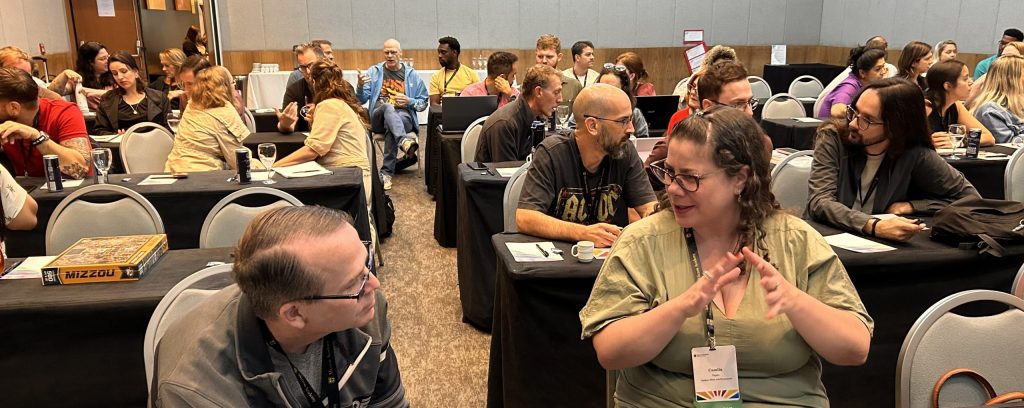Mizzou Academy Hosts Teaching and Learning Conference in São Paulo, SP
Posted in: News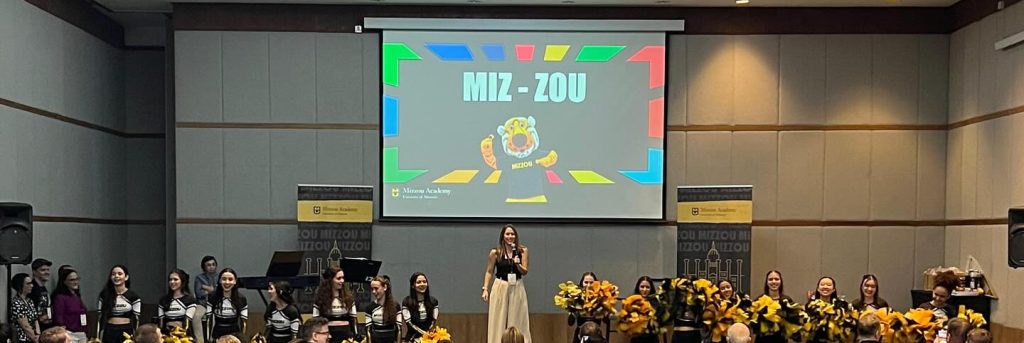
When Elementary Coordinator Lisa DeCastro took the microphone, she looked out into the audience and asked for grace. “This is my first time singing publicly like this.” She then led the 150 attendees in a West African welcome song called “Funga Alafia.” The song title translates from Yoruba to “greetings and blessings.” Music can be both a teaching tool and a vehicle to bring people together. At our recent teaching and learning conference in São Paulo, several members of our team leveraged the power of music in our first All-Conference Sing.
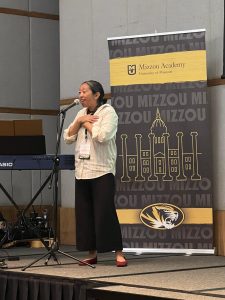
The teaching and learning conference is one of several regular professional development events that Mizzou Academy holds for partner teachers and coordinators in our elementary, middle, and high school programs. Executive Director Kathryn Fishman-Weaver says that this year’s theme, The United Nations SDGs in the Age of Artificial Intelligence, “invited educators and school leaders to consider teaching projects that matter.” In introducing the theme, she and Lead Teacher Jeff Kopolow referenced former U.S. representative John Lewis’ guiding principle of “good trouble.” This became a frequently referenced term throughout the conference.
Celebrating Multilingual Learners
Although he has attended the conference as a classroom teacher for many years, Jeff Healy presented as a faculty member for the first time this year. Healy joined the Mizzou Academy full-time as our Speech and Debate Lead in September 2024. He says, “Overall, the conference was excellent. The energy of having the partners together was great. The collaboration between teachers from various schools and the positive vibe was felt throughout each session.”
In addition to his sessions on Speech and Debate, Healy also presented with Global Partner Coordinator Roberta Franzoni Healy on strategies for supporting multilingual learners in the classroom. In these sessions, the Healys drew on their extensive background in teaching English to speakers of other languages. At Mizzou Academy, 90% of our student population speaks a home language other than English. This linguistic and geographical diversity is often cited as one of our school’s greatest strengths.
The Power of Student Voice
Fishman-Weaver says, “Each year, our student leaders are among our most important presenters, and this year was no exception.” Helena Spadini helped Fishman-Weaver open the conference with her talk on the importance of kindness and choosing your words carefully. Helena, who studies at Colegio Dante, is the first middle school student leader to present at this international event. In addition to Helena, the Colegio Magno Mizzou cheer team performed and assisted with the opening session.

On the second day of the conference, high school student leaders Mirela Cruz (Colegio Magno), and Isabela Abbud Silva and Carolina Ayyub (Colegio Dante) took the stage to share about their projects in connection with the United Nations SDGs.
The students were joined by Lorena Croce (Centro DaVinci), Maria Lucia da Fonte (Madre de Deus), and Cristina Calil Machado and Denise Smith (Colegio Dante) who also presented on student projects connected to global issues work.
These projects celebrated the ways students in our middle and high school programs are working on climate action, gender equity, sustainability, zero hunger, and expanding access to quality education.
Creativity and Authenticity in the Age of AI
Beginning on the second day of the conference, attendees were invited to “make their mark” on a large blank canvas. This invitation came from a session Fishman-Weaver and Jill Clingan had written on “using your teacher’s voice.”
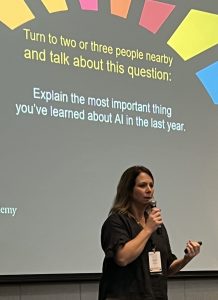
Much of this conference was about balancing creativity and authenticity with technology. How can we use one to leverage the other?
Throughout the conference, Middle School Coordinator Brian Suhlman led several sessions focused on middle school learning, teaching, and impact. In addition to these content sessions, he also led two thematic sessions called, “Thinking Beyond the Course Books” and “Using AI for Good.” Stuhlman’s session on AI was one of the most celebrated learning moments from the conference. Several attendees remarked that they came away from this session with actionable strategies and new tools to implement in their classrooms. Among these tools were Gamma.app, CoPilot, Perplexity, and Google LM. Stuhlman also pointed learners back to our open-access AI Shelf in the Learning Library.
Director of Teaching and Learning Stephanie Walter’s work happens at the intersection of AI and student work. Since 2023 when ChatGPT exploded onto the scene, the Mizzou Academy Team and their international partners have been immersed in research and professional development together. Walter led several sessions with partner teachers and coordinators to preview the 2025 course material. In each session, educators considered how AI impacts teaching and learning and how they could use AI to encourage stronger critical thinking and spark more creative expression. Walter reflects, “Some teachers shared how AI was making their lives easier by taking care of administrative tasks and freeing them up for ‘the good stuff’—tasks that required their expertise, human care, and knowledge of their students’ needs.” Teachers also shared strategies for students to use AI ethically and analytically. “The collective creativity of a group of passionate educators problem-solving is a sight to see,” says Walter. “I’m excited about what we’ll learn together in the next year.”
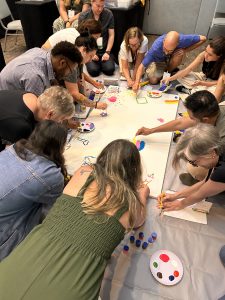
Several of Lisa DeCastro’s sessions pointed attendees back to the power of read-alouds. In one session, she was surprised and delighted that there were even more secondary teachers in attendance than elementary teachers. DeCastro says, “As we highlight and model that read-alouds matter, they will start to become more regular practices in classrooms.” This year, we were pleased to host a book raffle to help conference attendees stock their classroom libraries.
Walter and Fishman-Weaver helped educators think about this unique balancing act in their session on dialogue and discourse in the classroom. This session also drew on research by Mizzou Academy leads Jeff Healy and Jeff Kopolow.
Lift Every Voice and Learn
Renata Vaccari, Director of Brazil Operations, worked closely with the travel team and Ana Nikolau on conference logistics, operations, and coordinator support. Vaccari beams when talking about the conference. “The sessions were relevant and practical,” she says. They were deep in every sense they needed to be. They were also purposeful.”
Fishman-Weaver says that one such purposeful moment for her happened during the All-Conference Sing when she and Valerie Smallman, a language arts teacher at FourC Bilingual School, taught the song Lift Every Voice and Sing. This song, often referred to as “The Black National Anthem,” was initially written as a hymn by school principal James Weldon Johnson in 1900. James Weldon Johnson’s brother, John Rosamond Johnson, composed the music for the lyrics. The song was first performed by a choir of 500 schoolchildren at the segregated Stanton School, where James Weldon Johnson served as the principal. It was next performed in Jacksonville, Florida, to celebrate President Abraham Lincoln’s birthday.
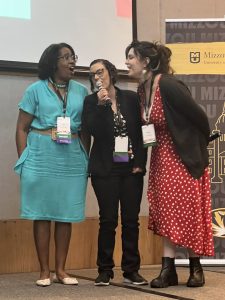
Smallman called the experience of teaching Lift Every Voice and Sing a “privilege.” Like many of our conference attendees, she was new to the song. “Believe it or not,” she says, “I had never heard this soul-stirring anthem. The moment I received the song assignment from Kathryn, I dove into learning about its origins and significance. Having taught U.S. History with the Mizzou program for seven years and being deeply passionate about human rights, I was profoundly moved as I uncovered the history of this song.” Smallman says that when everyone joined together in singing the song, “the experience was magical.”
Fishman-Weaver remembers “looking out across the 150+ educators who had gathered in São Paulo to learn with us about teaching projects that matter. As we sang together, I watched as our eyes pointed skyward to hit those high notes. I saw teachers link arms together. Some recorded the moment on their cell phones to play back later, while others settled into being fully present for this musical moment. While the moment was likely one that James Weldon Johnson couldn’t have imagined when he first wrote those lyrics 125 ago, and his words rang with relevance, power, and hope.”
Following the conference, Mizzou Academy high school students had the opportunity to present their own research on this theme at ESPM.
